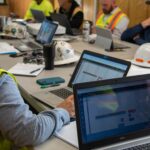I sat down with Michael Carr, President of Touchplan, to discuss with Lean consultant Hal Macomber how to get more out of the Last Planner® System by viewing it as a Kaizen method. Our conversation has been condensed and slightly edited.
Katherine Van Adzin: Could you start by defining Kaizen?
Hal Macomber: Kaizen is generally referred to as just continuous improvement. The term means “Kai, change—Zen, better,” so that’s the term that is generally used, although it’s misused. The Japanese have two words for improving. One is Kaizen, the other is Kairyo. And Kairyo loosely translates as, “change something.” How are Kaizen and Kairyo different? Zen is used to describe people, and how people are. Kaizen is a change for the better in oneself. The way it’s practiced is through making improvements to something, but the attention of Kaizen is on oneself.
Very few people ever make the distinction that I’m making, they miss it altogether. They think that Kaizen is waste elimination, and that’s the fundamental way people talk about it. Particularly in manufacturing situations, but also in healthcare situations, they focus their efforts on the artifacts, or the process steps without any reflection on oneself.
When Kaizen is well practiced, when improvement shows up as Kaizen it includes reflection, and in reflection we learn. The term for that is Hansei (“hahn-say”). When you do Kaizen, you must have reflection. It’s a matter of, “I had a problem, I made a change, it got a little bit better,” and “How was I impacted by that? What did I learn from that?”
KV: How did you begin to view the Last Planner System® as a Kaizen method?
HM: The concept of the Last Planner System® as a Kaizen method first came to me five or six years ago when I was introduced to the Kanban Method. Kanban is a simple visual way of displaying work and what state in the process the work is. It’s done at a personal level and it’s done on a team, but people have mistaken just visually displaying work as Kanban. Kanban’s a visual improvement method for the planning and delivery of work.
Now, it’s generally not seen as a method that has its attention on the person. It’s got its attention on the process, but that too is a mistake because in the Kanban space in general there are three major reasons why people are doing Kanban. One is to take better care of the clients. Another is to take better care of the company. The third, which is usually expressed as the first reason, is to take better care of oneself and each other, including learning.
We can use the Last Planner System® as an improvement method. Many teams are doing that, but it’s more like improving things, improving the way we plan and promise work, or improving the way we hang wallboard. All of that’s possible when using the Last Planner System®, but to make it a Kaizen method what would we be doing? What’s the fundamental change that would be a change for the better of the people, or for the people that are participating in the system?
Michael, what’s your take so far on what I’ve said?
Michael Carr: When we first started modeling the Last Planner System® in the computer we had a debate internally that didn’t last too long. The debate had to do with the role of the computer. One premise was, “Well, a computer can actually optimize. It could find the more optimal solution, the better solution and share that.” On the flip side, we had people who interpreted the Last Planner System® as a system that self-improves, so that as you use it you start homing in on the optimal solution by virtue of the fact that you’re following this process.
Ultimately, we abandoned the idea of having the computer do a calculation to tell you how good of a Last Planner® schedule or plan you’d come up with, and instead focused on having the computer just enable the collaboration, the dialogue, and eliminate some of the grunt work associated with the Last Planner System® just to make it easier to do the process because the process in and of itself led to incremental improvements. The team learns how to work together, and the byproduct of that is they actually get the result as opposed to having a computer tell them what to do.
HM: I’m sure you’ve seen graphs where they compare where an organization’s performance is that tries to make long step function change versus everyday continuous improvement. The suggestion is always that the organization’s performance is better if you do a little bit better every single day.
That gets you ahead, but it doesn’t preclude step function change along the way. The idea of making everyday change, like everybody making everyday, small change is like taking a shot on goal. It’s not a big deal. Take another shot in hockey, take a shot on the goal. And whether or not you get the goal, the more shots you take the better you get at taking shots, and the more likely you’re going to get the goal.
That’s the analogy, but we’re leaving out the person. The whole conversation leaves out the person making the change. “What’s going on for that person?”
MC: Right.
HM: Now, for example, take the Toyota company. They say their purpose for being is not to make better transportation systems for people. Their purpose for being is to develop human potential.
This purpose goes unnoticed or is ignored. On any given day if you are looking on LinkedIn and you’re following the keyword “Lean,” you’re going to get all kinds of stuff about what people say Lean is and what it’s doing, and for the most part there’s no conversation about what’s happening to people. If there is, it’s purely incidental.
Jumping off from there, how is it that the Last Planner System® could be a Kaizen method? When Glenn Ballard and Greg Howell developed the Last Planner System® from the earliest days they had feedback loops, multiple feedback loops in the system. The current depiction goes from master scheduling to phase scheduling, to make ready planning, weekly work planning (the act of promising), and then daily commitment management. That’s the current way it’s described. There’s a result from each step in the process.
“Oh. I did something. This is what happened. How do I make it better?” In the act of making it better we get more competent at whatever that step in the process was.
We’re designing a Lean production system through pull planning. What’s the measure of a Lean production system? Work flows uninterrupted, or in other words, value is accumulated uninterrupted for a flow unit of whatever it is we’re doing.
MC: Right.
HM: The process, the kind of best practice today for designing for uninterrupted flow is called Takt time planning. You pull your project and then you Takt time plan it through the steps of the process. Most people stop pull planning once they’ve done a good job of sequencing work for the benefit of their customers and they think that’s done. It’s certainly much better than what we were doing before, but it doesn’t give you flow. These feedback loops for many project situations are poorly executed, or not executed.
MC: Yeah. I think that a lot of thought went into the Last Planner System® and it’s clear that the process is designed to—if you follow it—lead to a whole bunch of personal improvement. You’re better at planning, you’re better at identifying problems early and clearing things up. You’re better at sharing bad news early, you’re better at thinking together as a group and coming up with a novel solution. You’re better at really understanding how what you do impacts other folks.
There’s a lot there, but you’re absolutely right. When it comes to metrics that are being measured or captured very few are out there that people know about. An improvement would be to find a way to put more of that in people’s hands because what you measure, you improve on. It’s just natural.
And the Last Planner System® didn’t start out looking like it is today. They kept adding things to deal with the conditions or situations that they saw, and it resulted in this system that really does work if you follow it, but very few people follow it.
It might be useful just to say, “At the end of a well-run Last Planner® initiative within an organization or a team, here are the things that you should see on your projects. Here are characteristics that you should see for PPC and flow, etc. so they would continue to refine it. And throughout the process, awareness of the overall objective of improvement helps motivate people.
HM: Understanding the fit-for-purpose measurements is key to having a system that can, with the performance of the team, improve over time. We have to be putting those metrics in front of the people so that they can learn, improve and adjust their actions.
You have no chance of maintaining flow if you’re not doing end-of-day commitment management meetings. You must course correct every day with everybody. You can have all of the correct measurements—not that most people do—but you can have all the correct measurements and practices in place that will result in improved flow and shorter projects, but what about the people? How do we make this a set of a practices that enables people to become more competent builders?
MC: Yeah.
HM: One of the big opportunities that the Last Planner System® can pursue is that everyone is becoming better builders, and they’re becoming better planners. We put them in situations where the framer treats the plumber as his customer, and the plumber treats the electrician as his customer, and then the electrician treats the framer as his customer when the framer puts all the blocking in the wall.
This performer-customer relationship is fundamentally changing the social dynamics on the project. You can manifest it on a project, which we set out to do every single time on my Last Planner System® implementations. When you do that you learn so much more about what’s going on, and you learn directly from your customer. That feedback directly from your customer is an opportunity for each performing unit to grow.
Now, it’s not the only opportunity. Actually getting trades to practice Kaizen on their work for the sake of becoming better tradespeople and delivering better quality is very useful, but that’s not what we’re talking about here. We’re talking today about, “How can the Last Planner System® be embraced as a Kaizen method?”
Let’s just talk about what’s critical if you want the Last Planner System® to function as a Kaizen method.
Number one, you have to have timely availability of data to drive decisions, and drive improvement, which drives learning. With Touchplan you have timely availability of the data and what was done today, and immediately you can find out how you’re doing. It’s more important on the bigger projects than the small projects because if you have manual reporting of what’s going on it could be a couple days before anybody could see across the project what’s happening. Even walking the floor doesn’t help you see what’s happening. You could be out there all day long and you’re not understanding how things are changing on you. It starts with measuring the right things and making sure you have measurements on anything that you want to improve, and that you have a way of making that data available in a timely way.
We’re also redefining the working relationships here. You don’t work for the superintendent, you work for each other. The next person in line is your customer, and perhaps two or three people later on in line are still your customers. Daily commitment management meetings at the end of the day or stand-ups that only last a few minutes are critical. You get to hear directly from the person you’re handing off that space to.
What else is necessary? One of the things that’s very helpful is to have people tell you what they’re interested in learning. It’s kind of a silly or obvious thing to say, but we don’t know. Foremen sometimes don’t know what their people need to learn because they have them doing the same thing every day. The better teams are talking to each other about what they’re trying to learn.
We have to be clear that we made an improvement, and that we’ve learned from the improvement, and without reflection that doesn’t happen. At any meeting that happens that takes thirty minutes or longer—it’s kind of the rule of thumb to do a plus delta—ask “What produced value? What should be changed to produce more value? What are individuals learning? What are you learning while you’re doing your work? What are you learning while you’re doing your planning? What are you doing while you’re doing promising?”
We’re not putting enough reflection on purpose and by design into our process. Building recurrent reflection for learning into our process is critical.
MC: I would add that there are obvious things that you would expect people to learn when they do their reflection. Being deliberate about showing them what you expect that they should learn, then helping them to do those things, and then getting them to do them on their own goes a long way in accelerating this self-improvement. Also, whatever it is that you’re trying to get people to learn, if there’s somebody there who’s learned it, the rest can learn from that person’s experience. And of course, if there is a mentor to bring you through a situation, or share their learning, it can really help accelerate this learning further.
HM: And that’s just one example of a facilitative skill that you want from that person and we don’t regularly get it from everyone. But we all have that capability to bring caring for those people that we’re working with. We might not have the habit of doing it, but we have the capability of doing it. We just need to introduce practices for it.
The Last Planner System® will be a Kaizen method when we make it so.










